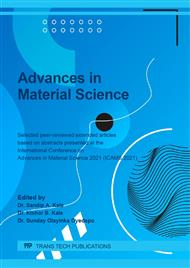[1]
Ryu, Chung-Hyeon, et al. Nondestructive evaluation of hidden multi-delamination in a glass-fibre-reinforced plastic composite using terahertz spectroscopy., Composite Structures 156 (2016) 338-347.
DOI: 10.1016/j.compstruct.2015.09.055
Google Scholar
[2]
Mohan, N. S., S. M. Kulkarni, and A. Ramachandra. Delamination analysis in drilling process of glass fiber reinforced plastic (GFRP) composite materials., Journal of Materials Processing Technology 186.1-3 (2007) 265-271.
DOI: 10.1016/j.jmatprotec.2006.12.043
Google Scholar
[3]
Patterson, Brendan A., et al. Influence of temperature dependent matrix properties on the high-rate impact performance of thin glass fiber reinforced composites., Composites Part B: Engineering 192 (2020) 108009.
DOI: 10.1016/j.compositesb.2020.108009
Google Scholar
[4]
Kumar, Pawan, et al. Effect of Rate of Loading on Jute Fibre-Reinforced Polymer Composite., Transactions of the Indian Institute of Metals (2020) 1-5.
Google Scholar
[5]
Mufti, Aftab, et al. Durability of GFRP reinforced concrete in field structures., Proceedings of the 7th international symposium on fiber-reinforced polymer reinforcement for reinforced concrete structures (FRPRCS-7), Kansas City, Mo. (2005).
DOI: 10.14359/14898
Google Scholar
[6]
Yang, Xiao, Yu Bai, and Faxing Ding. Structural performance of a large-scale space frame assembled using pultruded GFRP composites., Composite Structures 133 (2015) 986-996.
DOI: 10.1016/j.compstruct.2015.07.120
Google Scholar
[7]
Ribeiro, M. C. S., et al. Re-use assessment of thermoset composite wastes as aggregate and filler replacement for concrete-polymer composite materials: A case study regarding GFRP pultrusion wastes., Resources, Conservation and Recycling 104 (2015) 417-426.
DOI: 10.1016/j.resconrec.2013.10.001
Google Scholar
[8]
Sendeckyj, G. P. Effects of defects in composite structures., (1983).
Google Scholar
[9]
Senthil, K., et al. Defects in composite structures: Its effects and prediction methods–A comprehensive review., Composite Structures 106 (2013) 139-149.
DOI: 10.1016/j.compstruct.2013.06.008
Google Scholar
[10]
Pereszlai, Csongor, et al. Drilling fibre reinforced polymer composites (CFRP and GFRP): An analysis of the cutting force of the tilted helical milling process., Composite Structures 262 (2021): 113646.
DOI: 10.1016/j.compstruct.2021.113646
Google Scholar
[11]
Yao, X. F., et al. Tensile strength and fracture behaviours of complex GFRP composites with a central hole., Journal of composite materials 39.14 (2005) 1247-1260.
DOI: 10.1177/0021998305049054
Google Scholar
[12]
Afaghi-Khatibi, Akbar, Lin Ye, and Yiu-Wing Mat. An effective crack growth model for residual strength evaluation of composite laminates with circular holes., Journal of Composite Materials 30.2 (1996) 142-163.
DOI: 10.1177/002199839603000201
Google Scholar
[13]
Eriksson, Ingvar, and Carl-Gustaf Aronsson. Strength of tensile loaded graphite/epoxy laminates containing cracks, open and filled holes., Journal of composite materials 24.5 (1990): 456-482.
DOI: 10.1177/002199839002400501
Google Scholar
[14]
Backlund, Jan, and Carl-Gustaf Aronsson. Tensile fracture of laminates with holes., Journal of Composite Materials 20.3 (1986) 259-286.
DOI: 10.1177/002199838602000304
Google Scholar
[15]
Khashaba, U. A. Fracture behaviour of woven composites containing various cracks geometry., Journal of composite materials 37.1 (2003) 5-20.
DOI: 10.1177/0021998303037001679
Google Scholar
[16]
Garrett, R. A. Effect of defects on aircraft composite structures. Mcdonnell Aircraft Co St Louis Mo, (1983).
Google Scholar
[17]
Woigk, Wilhelm, et al. Experimental investigation of the effect of defects in Automated Fibre Placement produced composite laminates., Composite Structures 201 (2018): 1004-1017.
DOI: 10.1016/j.compstruct.2018.06.078
Google Scholar
[18]
Wickramasinghe, Sachini, Truong Do, and Phuong Tran. FDM-based 3D printing of polymer and associated composite: A review on mechanical properties, defects and treatments., Polymers 12.7 (2020) 1529.
DOI: 10.3390/polym12071529
Google Scholar
[19]
Padmanabhan, K., and Kishore. Influence of circular defects on the flexural strength of Kevlar/epoxy composites., Journal of reinforced plastics and composites 11.2 (1992) 211-219.
DOI: 10.1177/073168449201100207
Google Scholar



